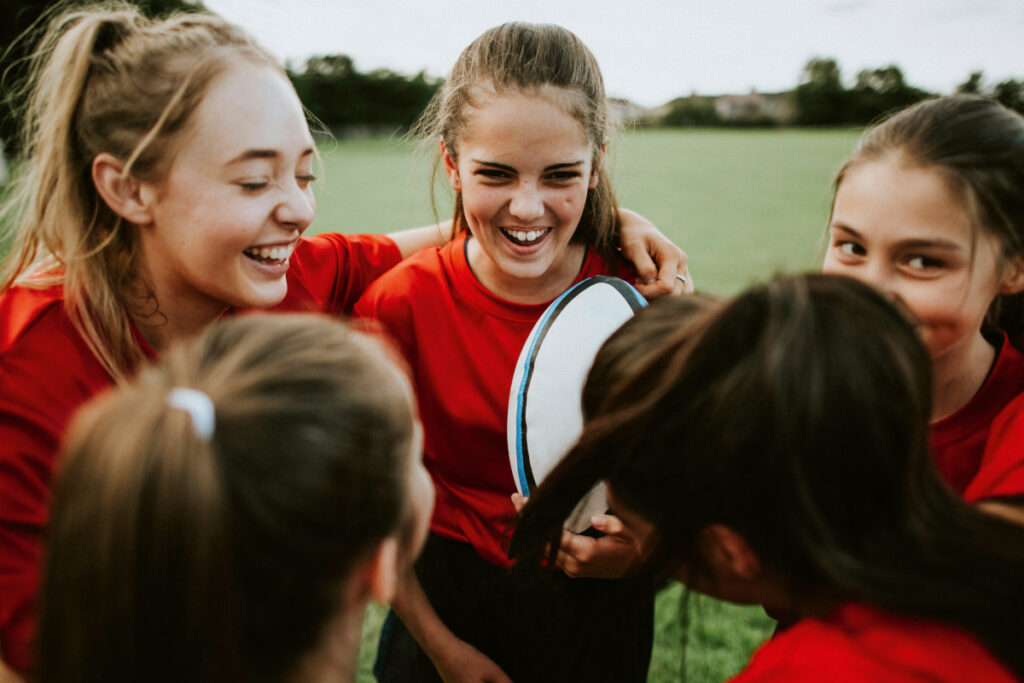[LUM#20] “There are still very few girls who play rugby.”
According to INSEE, 87% of boys aged 13 and 14 participate in sports, compared to 78% of girls. Among girls, one-third participate in competitions, compared to half of boys. Julie Boiché, social psychology researcher at Euromov DHM1, explains how the persistence of gender stereotypes in sport creates and perpetuates this difference.


How would you define gender stereotyping?
Julie Boiché: In social psychology, stereotyping refers to the characteristics, whether physical, psychological, or behavioral, that are socially attributed to the female and male genders.
You have taken an interest in gender stereotypes in sport. Why is that?
J.B.: Together with Melissa Plaza, who wrote her thesis under my supervision, we started from the observation that girls and women engage in less physical activity than boys and men. Although discourse and norms convey fewer stereotypes today, in reality they still exist.
You followed several cohorts of students from sixth grade to twelfth grade during a survey. What kind of questions did you ask them?
J.B.: We might ask them, for example, "How important do you think sports are for girls?" "How good are they at sports?" Then we ask exactly the same questions about boys, and we see if there is a difference in perception between girls and boys.
So what?
J.B.: We see that by sixth grade, boys have, on average, already internalized a stereotype that favors them, namely that they are better than girls and that playing sports is more important for them. Girls generally have fairly neutral responses at the beginning of secondary school, but during middle school, we see a change: they tend to internalize the idea that they are less athletic than boys and that it is less important for them to participate in sports.
You have explored gender perceptions of different sports. What did you find?
J.B.: Many sports are still perceived as masculine: combat sports, motor sports, and contact team sports such as rugby. Some activities are considered more neutral, such as racket sports and athletics, while dance, yoga, gymnastics, and horse riding are still predominantly female today.
And is this reflected in the numbers of male and female participants?
J.B.: We cross-referenced these responses with data provided by the federations, and yes, there is a very strong correlation between gendered perceptions of sports and actual participation. To put it simply, there are still very few girls who play rugby and few boys who dance, and so the situation tends to repeat itself because it's not easy to be "the only girl" among boys or vice versa.
You also had elementary school children draw pictures...
J.B.: Yes, with Claire Bréchet from the Epsylon laboratory, we asked them to draw a child playing sports. The boys all spontaneously drew a boy, while only two-thirds of the girls drew a girl. The sports represented included the most popular ones, such as soccer, for both boys and girls. We also noticed that girls were depicted playing sports considered "masculine," "neutral," or "feminine," while boys were mainly confined to "masculine" sports. We can see that they too are excluded from certain activities and that this issue has not been resolved. There can still be difficulties in accessing certain activities, and the young people's social circle plays a big role in this.
You surveyed parents. Are these stereotypes passed down within families?
J.B.: Among adults, 85% of responses were neutral, which is a sign that anti-sexist norms have taken hold, which is good news. However, when we give them tasks that are less explicit than a questionnaire, links between the stereotypes of parents and those of children emerge, which we can interpret as a form of transmission.
You show that these stereotypes contribute to a higher dropout rate in sports among girls than boys. When does this dropout occur?
J.B.: From the outset, the vast majority of children who do not participate in sports at all (outside of physical education) are girls. We then see more girls dropping out during adolescence, and the presence of gender stereotypes is one of the hypotheses to explain this. Either because they have internalized these beliefs that are unfavorable to them, or because they are less socially encouraged to continue.
With lifelong consequences?
J.B.: Yes, the less you exercise at that age, the less likely you are to exercise as an adult, with all the issues that entails in terms of sedentary lifestyles and the importance of getting enough physical activity for good health.
Are public policies addressing this issue?
J.B.: Yes, but even proactive policies sometimes come up against stereotypes. For example, in some cities where sports facilities have been installed in public spaces to make it easier for everyone to access sport, they are quickly "taken over" by boys. Instead of combating the stereotype, this reinforces it, as boys take over a new sporting territory, which reinforces the idea among girls that it is not for them.
So gender stereotypes still have a long way to go?
J.B.: We believe we live in a more open era, and that's true to a certain extent, but there are still many shocking things. There's the whole issue of media coverage and the promotion of women's sports. Some groups of female athletes have rebelled against the inappropriate outfits that federations impose on them... There's still a long way to go!
Find UM podcasts now available on your favorite platform (Spotify, Deezer, Apple Podcasts, Amazon Music, etc.).
- Euromov (UM, IMT Mines Ales)
↩︎